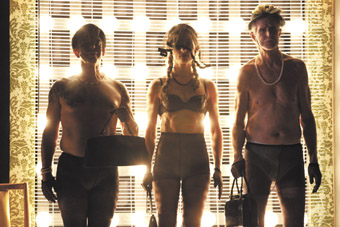 |
Omar Ebrahim, Deborah Kayser, Philip Larson, The Navigator photo Justin Nicholas |
Other archetypal characters intersecting with her journey are the Fool, The Angel of History and the Crone. Baritone Omar Ebrahim as The Fool—a minotaur like figure, huge horns, huge male genitalia—courses from male polarity to female, producing ‘reality’ in the world as we know it, according to the system of the Tarot. Similarly, Philip Larson, as The Crone questions essentialist myths of gender. The Angel of History is graphically, irruptively enacted by baroque alto Deborah Kayser in a full-skirted ball gown, gnashing and growling in an aphasic, deep masculine register as ‘he’ sees “one single catastrophe that keeps piling ruin upon ruin and hurls it in front of his feet” (Walter Benjamin). As the program notes, “The Angel’s gaze takes in landscapes of tidal blood, unwinding rivers, glaciers, a comet, the ocean, the desert, and finally—in a vision of rebirth during which a cicada is placed on the eye of a foetus—the submarine amniotic world of the womb.”
As director and designer Barrie Kosky, far from being ‘iconoclastic’, handled the mythic dimension of this work with great precision and astuteness in his decision making. As a backdrop to his painterly tableaux a series of confined urban spaces are represented as a flat, continuous and uncluttered collage. A shallow stage and intense and clever lighting contributed to create stage pictures of extreme visual potency: a Tiresias-like old man/woman, sorrowful and strong; roses above a doorway become a brothel’s red light; Max Ernst-like creatures shuffle in and out of the brothel. An array of symbolic costume changes added to the surreal effect.
The Beloved, soprano Talise Trevigne, nightclub svelte in a simple purple silk shift sings like a siren. She is the essence of longing and loss. The Navigator, her other, is the potently beautiful counter-tenor, Andrew Watts, sometimes also in a purple silk shift. Cross-dressing is not fortuitous, however, but an artful play of signs. In this context, it’s interesting that Virginia Woolf considered it was “fatal” for an artist to be simply a man or a woman. Following on from Woolf, Hélène Cixous maintains “that there is no invention possible…without there being in the inventing subject an abundance of the other, of variety.” Tristan and Isolde’s mythical love affair, at least from Wagner’s revisionist perspective, was all in the mind, more intimate, more profound than sex. Their deeper reality was riven through by the same cosmic forces of creation and destruction, of Eros and Thanatos, that course through Lim’s and Syke’s imaginative world. Indeed, simply as an artist, Lim appears to be enthralled by the infinite musical possibilities of alterity and otherness.
Genevieve Lacey, as a young girl in an animal mask, pouring her soul into a Ganassi recorder is our overture. This instrument with its lamenting tonality speaks of an otherworldly eroticism and is urgently counterpointed by the incessant cicada sounds that signal “a high pitch of desire” for the other. The sheer carnality of the embodied voices of the singers, pitched to the many tensions of desire expressed in this work paradoxically raised them to a mythic level. Conductor, Manuel Lawri, draws forth too, from the superb Elision Ensemble, complex aural landscapes that illuminate and interpenetrate the cosmos-encompassing stage action, completing what Kosky promised, “a fugue of the senses.”
Kosky’s triumphant and sumptuous final stage picture reunites The Beloved and The Navigator in a sonorous affirmation that a cycle has been completed. The sound of the Sirens falls away, their final invocation of the cicada placed on the eye of a foetus a promise of “infinity’s dark longing to perfect its own.” They sing of “desire’s timeless valve opening...closing...opening.”
The Navigator can be seen in the Melbourne International Arts Festival, Playhouse, Arts Centre, Oct 9-12. www.melbournefestival.com.au
Brisbane Festival 2008, The Navigator, composer Liza Lim, librettist Patricia Sykes, director Barrie Kosky, performers Talise Trevigne, Andrew Watts, Omar Ebrahim, Deborah Kayser, Philip Larson,conductor Manuel Lawri, recorder Genevieve Lacey, Elision Ensemble, design Barrie Kosky, costumes Alice Babbidge, lighting Damien Cooper, sound Michael Hughes, Judith Wright Centre, Brisbane, July 30-Aug 2
RealTime issue #87 Oct-Nov 2008 pg. 8
© Douglas Leonard; for permission to reproduce apply to [email protected]








 back
back